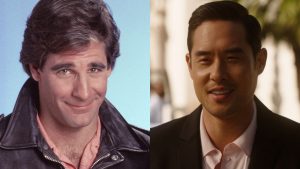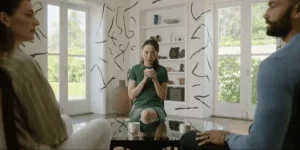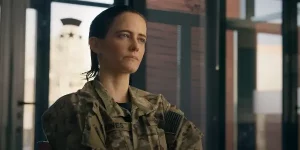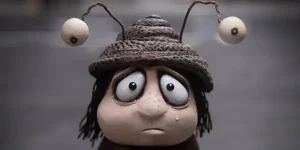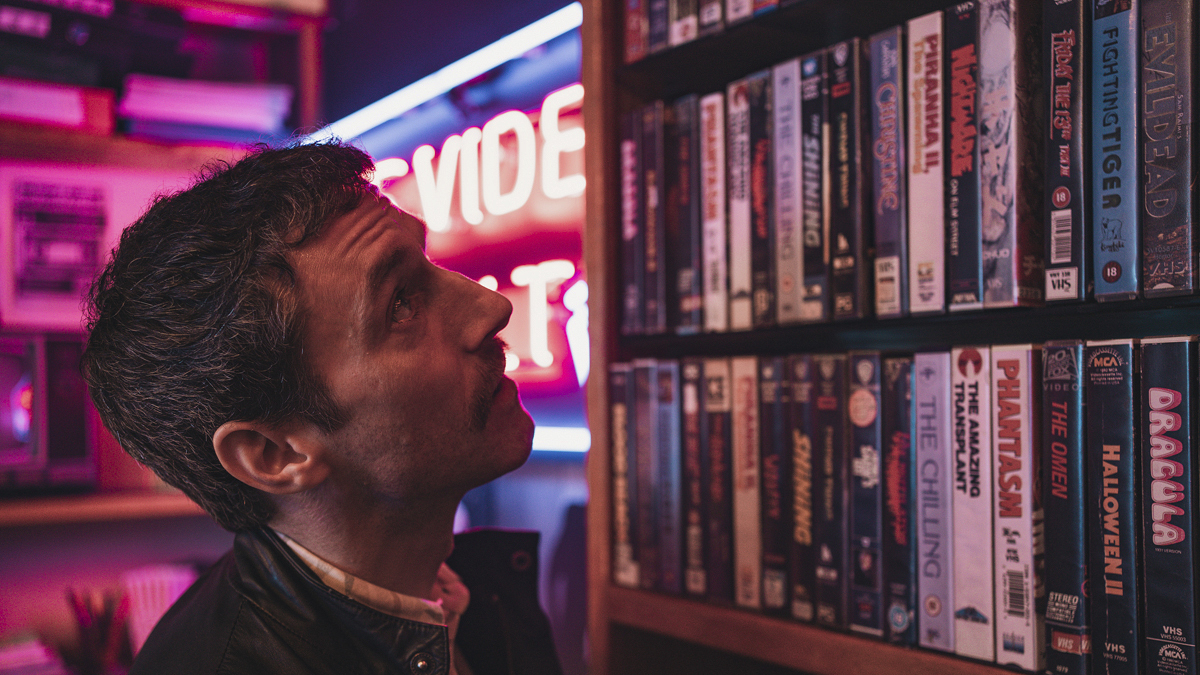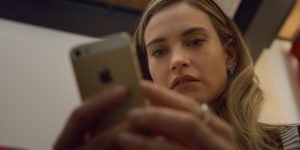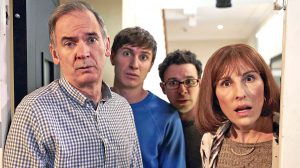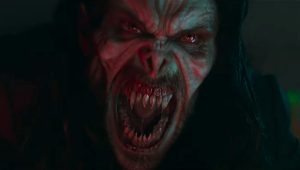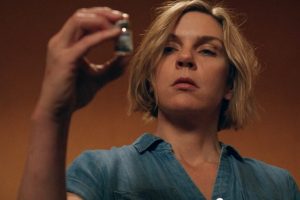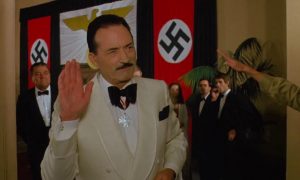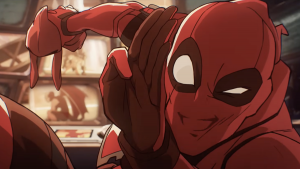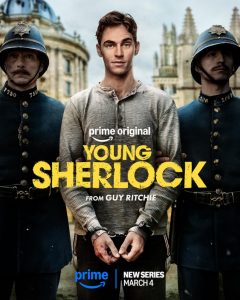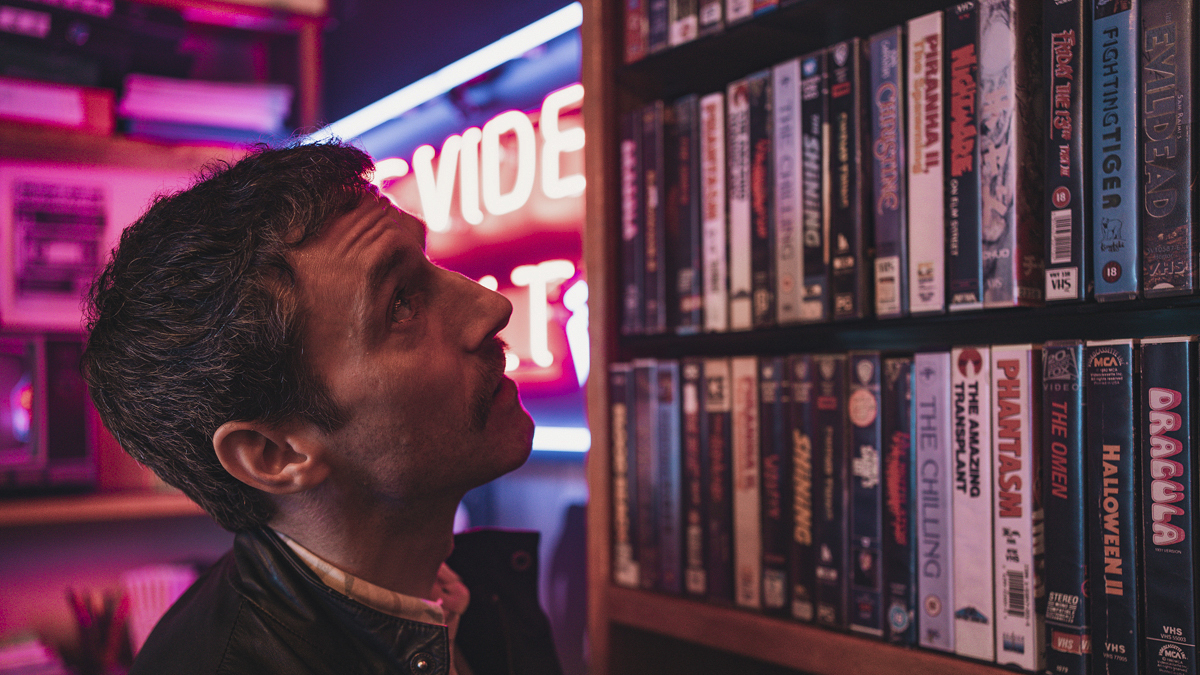
When the UK Department for Public Prosecutions published in 1983 a list of “video nasty” titles which could result in prosecution for distributors, it didn’t know that it was setting horror fans a Pokémon-style “gotta catch ‘em all” challenge. The films that appeared on the list became the DPP 72, an infamous collection of cult horror movies curated by moral outrage.
In new 1980s-set BBC Three comedy-drama Video Nasty, Dublin teenagers Billy (Justin Daniels Anene) and Con (Cal O’Driscoll) are one title away from completing their illicit DPP 72 collection. Through underground deals, back-of-a-van trades and overseas pen pals contacted through the pages of Fangoria magazine, they’ve amassed almost every one of the VHS movies that slipped through the brief legal loophole that allowed the distribution of unregulated videos in the UK.
Only William Asher’s 1981 flick Nightmare Maker aka Butcher, Baker, Nightmare Maker aka The Evil Protégé, is needed to round off the boys’ collection. In episode one, they get a lead on a copy, which takes them, along with Con’s sister Zoe (Leia Murphy), to the North of England and into a Wicker Man-style horror movie of their own.
Without spoiling everything that happens to the trio over the six episodes, these nice, fairly well-adjusted kids become unfairly framed as poster children for the mind-warping effects of video nasties, against which a group of moral arbiters are campaigning. The anti-filth activists go to extreme lengths to make their point under the banner of protecting vulnerable young minds. Pillar-of-the-community figures from the church and the police, seeking to eliminate harmful influences on the nation’s youth, take matters into their own hands.
Written by Hugh Travers, and directed by Christopher Smith and Megan K. Fox, Video Nasty is a fun, horror-infused romp, but also a neat satire that comments on real events during the 1980s video nasty moral panic in the UK. (Cast member Simone Kirby described her character to Irish News as a combination of UK anti-filth activist Mary Whitehouse and US agitator Phyllis Schlafly.) The show’s heightened, bloody story has its satirical roots in real lies told by establishment figures to suit their own hypocritical agenda.
The Real-Life Moral Panic
As explored in depth in Jake West’s 2010 documentary Video Nasties: Moral Panic, Censorship and Videotape, the press and parliamentary campaigns against unregulated VHS horror movies in the early 1980s were nothing short of hysterical. Video nasties were blamed for driving young people to acts of sadistic violence, and out onto the streets to riot. According to successive newspaper articles, among them The Daily Mail’s “Ban the Sadist Videos” series, schoolchildren were being exposed to degraded acts that were warping their minds.
In one memorable and understandably oft-mocked statement by Graham Bright MP, the man behind the Bright Bill that led to the 1984 Video Recordings Act being passed, research was taking place that wouldn’t only show the harmful effect of these films on young people, but also on dogs.
With Britain’s youth and household pets at such risk, research was taking place, but apparently not fast enough for the campaigners. The Parliamentary Group Video Enquiry (parliamentary in name only) in association with a unit at Oxford Polytechnic published a report in November 1983 titled “Video Violence and Children”, which testified as to how wide this video nasty influence had spread. Newspapers and TV channels leapt on the findings and reported that children as young as five were routinely watching extreme horror at home on VHS, schoolkids were pooling their pocket money to rent Cannibal Holocaust and its ilk, and tiny minds were being led to commit unspeakable acts.
Journalists, MPs and campaigners agreed: these videos needed to be seized and destroyed, and nothing like them should ever be allowed to fall into the hands of children again.
Left out of the report was the vital context that a week before publication, the Oxford Polytechnic unit led by Brian Brown had repudiated its framework and conclusions. The report’s research was criticised as having been insubstantial, untrustworthy and poorly gathered. Sample sizes were judged unrepresentative, and insufficient follow-up had been made to questionnaires that asked young children simply to tick which horror titles from they’d seen from a given list. As reported by The Guardian newspaper, the conclusions were judged by Brown and colleagues to be more opinion than research. The report had been rushed through and the findings partly invented to suit a political agenda.
The UK in the early 1980s was a place of unrest. Unemployment was high, the miners’ strikes were being brutally put down by police, and young people did riot on the streets. Keen to present itself as the party of law, order and family values, it suited Margaret Thatcher’s conservative government to blame a scapegoat – the video nasty – for the tumult.
And it worked. In 1984, Graham Bright’s Video Recordings Act was passed requiring that VHS titles passed through BBFC censorship before UK distribution. Legislation had been passed that, according to academic and British cultural historian Martin Barker, was based on fraudulent justification and whipped-up moral panic. As Barker warns in West’s documentary – if it happened then, it can (and clearly has) happened since.
That’s what makes BBC Three’s Video Nasty more than just a fun horror romp. It’s also a vital reminder of a time when the institutions claiming to be our moral guardians ran roughshod over the truth to suit their own goals. As such, this 1980s-set show with its retro, Stranger Things atmosphere, may actually be one of the timeliest around.
Video Nasty is available to stream in full now on BBC iPlayer.
The post Video Nasty: the True Story Behind the 1980s-Set Banned Horror Movie Series appeared first on Den of Geek.
